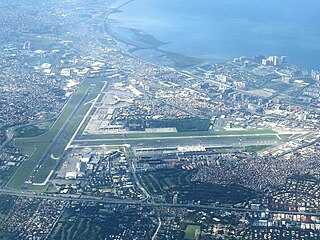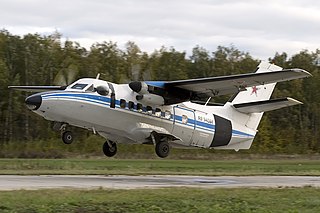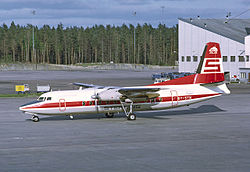
Ninoy Aquino International Airport, originally known as Manila International Airport (MIA), is the main international airport serving the Manila metropolitan area in the Philippines. Located between the cities of Pasay and Parañaque, about 7 kilometers (4.3 mi) south of Manila proper and southwest of Makati, it is the main gateway for travelers to the Philippines and serves as a hub for AirSWIFT, PAL Express, and Philippine Airlines. It is also the main operating base for Cebgo, Cebu Pacific, and Philippines AirAsia.

Zest Airways, Inc., operated as AirAsia Zest, was a Filipino low-cost airline based at Ninoy Aquino International Airport in Pasay, Metro Manila in the Philippines. It operated scheduled domestic and international tourist services, mainly feeder services linking Manila and Cebu with 24 domestic destinations in support of the trunk route operations of other airlines.
Laoag International Airlines was an airline based in the Philippines. It shut down when one of its aircraft, Flight 585 crashed in Manila Bay in 2002.
Pacific East Asia Cargo Airlines, Inc. was a cargo airline based in Pasay, Philippines. The carrier served domestic services from the Philippines with two Boeing 727 freighter aircraft. The airline also had an agreement on selected routes flown by Air Philippines. PEAC was also an affiliate airline of TNT Airways, with PEAC operating TNT leased BAe 146 aircraft.
Pacific Airways Corporation operating as Pacificair is a charter airline based in Manila in the Philippines. It operates scheduled passenger flights, as well as air taxi services, and agricultural work. Its main base is Ninoy Aquino International Airport, Manila.

Subic Bay International Airport serves as a secondary and diversion airport for Ninoy Aquino International Airport in Metro Manila and Clark International Airport in Pampanga. It also serves the immediate area of the Subic Bay Freeport Zone, the provinces of Bataan and Zambales, and the general area of Olongapo in the Philippines.

Cebu Pacific Flight 387 was a domestic Cebu Pacific flight from Ninoy Aquino International Airport in Metro Manila to Lumbia Airport in Cagayan de Oro. On February 2, 1998, the 31-year-old McDonnell Douglas DC-9-32 crashed on the slopes of Mount Sumagaya in Claveria. The incident resulted in the deaths of all 104 passengers and crew on board.

Philippine Airlines Flight 137 was a scheduled passenger flight from Manila's Ninoy Aquino International Airport to Bacolod City Domestic Airport.

Philippine Airlines Flight 812 was a scheduled domestic passenger flight from Francisco Bangoy International Airport in Davao City to Ninoy Aquino International Airport near Manila. On May 25, 2000, an Airbus A330-301 operating on the route was hijacked by a man later identified as Reginald Chua, just before the airplane was about to land. The flight carried 278 passengers and 13 crew members.

Air Philippines Flight 541 was a scheduled domestic flight operated by Air Philippines from Ninoy Aquino International Airport in Manila to Francisco Bangoy International Airport in Davao City. On April 19, 2000, the Boeing 737-2H4 crashed in Samal, Davao del Norte while on approach to the airport, killing all 124 passengers and 7 crew members. It remains the deadliest air disaster in the Philippines and the third deadliest accident involving the Boeing 737-200, after Mandala Airlines Flight 091, which crashed 5 years later, and Indian Airlines Flight 113.

Asian Spirit Flight 100 was a Let L-410 Turbolet that crashed into a mountainside between the municipalities of Kasibu, Nueva Vizcaya, and Cabarroguis, Quirino, in the Philippines on December 7, 1999. The aircraft was en route to Cauayan in Isabela from Ninoy Aquino International Airport in Manila. All fifteen passengers and two crew aboard the flight died in the incident.

Philippine Airlines Flight 206 (PR206) was the route designator of a domestic flight from the Manila Domestic Airport, Metro Manila, Philippines to Loakan Airport, Baguio. On June 26, 1987, the Hawker Siddeley HS 748 crashed onto a mountain en route to Baguio, killing all 50 people on board.
Air Philippines Corporation, operating as PAL Express and formerly branded as Air Philippines and Airphil Express, is a wholly-owned subsidiary airline of Philippine Airlines. It is PAL's regional brand, with services from its hubs in Manila, Clark, Cebu, and Davao.

On 5 August 1984, a Biman Bangladesh Airlines Fokker F27-600 crashed into a marsh near Zia International Airport in Dhaka, Bangladesh while landing in poor weather. The aircraft was performing a scheduled domestic passenger flight between Patenga Airport, Chittagong and Zia International Airport, Dhaka.

XiamenAir Flight 8667 was a scheduled international passenger flight from Xiamen Gaoqi International Airport in Xiamen, China, to Ninoy Aquino International Airport in Manila, Philippines. On 16 August 2018, the Boeing 737-800 operating this flight skidded off the runway while attempting to land in poor weather conditions. The crash occurred at 11:55 p.m. Philippine Standard Time (UTC+8), resulting in the destruction of the aircraft. No serious injuries were reported among the crew or passengers. The damaged aircraft took 36 hours to remove from the runway, leading to a major disruption at the airport, which is the primary international gateway to the Philippines. The closure caused the cancellation of more than 200 domestic and international flights, affected more than 250,000 travelers, and prompted calls for enlargement of the airport or the construction of alternative airports to serve the country in the event of future disruptions.

On September 1, 2019, a Beechcraft King Air 350 crashed into a tourist resort in Calamba, Laguna, Philippines while performing a medevac flight from Dipolog to Manila. All nine occupants aboard were killed in the crash.
Aerolift Philippines Flight 075 was a scheduled domestic flight from Ninoy Aquino International Airport to Surigao Airport. On 18 May 1990, the Beechcraft 1900 operating the flight crashed just after takeoff, 1 km south of the airport, killing all 19 passengers and 2 crew, as well as a family of four on the ground. Flight 75 was the second fatal accident of a Beechcraft 1900 and remains the worst loss of life in a crash involving that model.

Korean Air Flight 631 (KE631/KAL631) was a scheduled passenger flight from Incheon International Airport near Seoul, South Korea to Mactan–Cebu International Airport in Metro Cebu, Philippines. On October 23, 2022, the Airbus A330-300 operating this flight overran the runway while landing in Cebu due to hydraulic failure. Despite what reports described as a "terrifying close call," all passengers and crew members survived without injuries. However, the aircraft was damaged beyond repair and written off as a result of the accident, making it the 14th hull loss of an Airbus A330.













